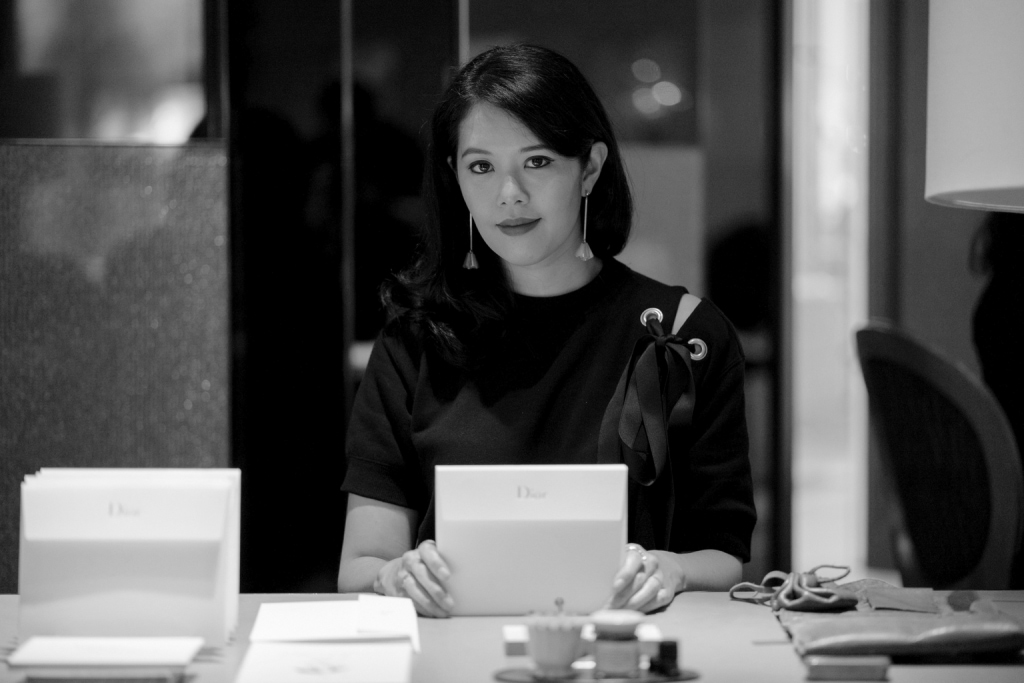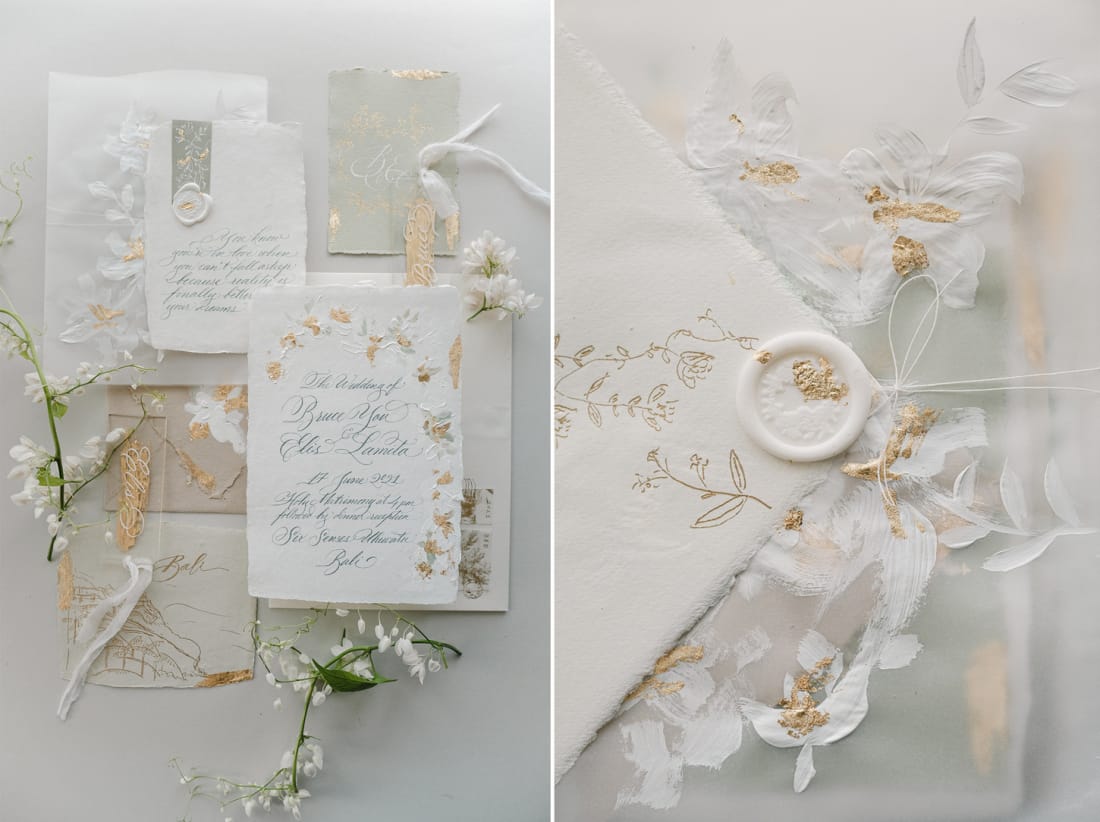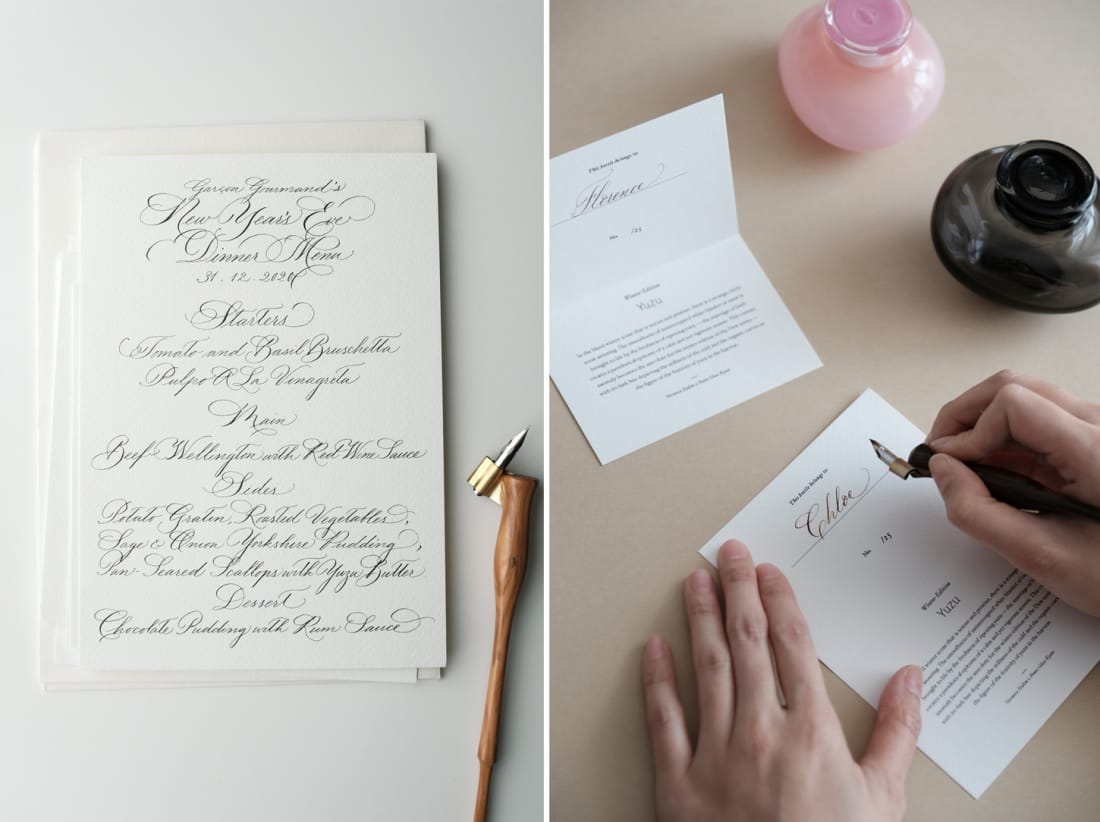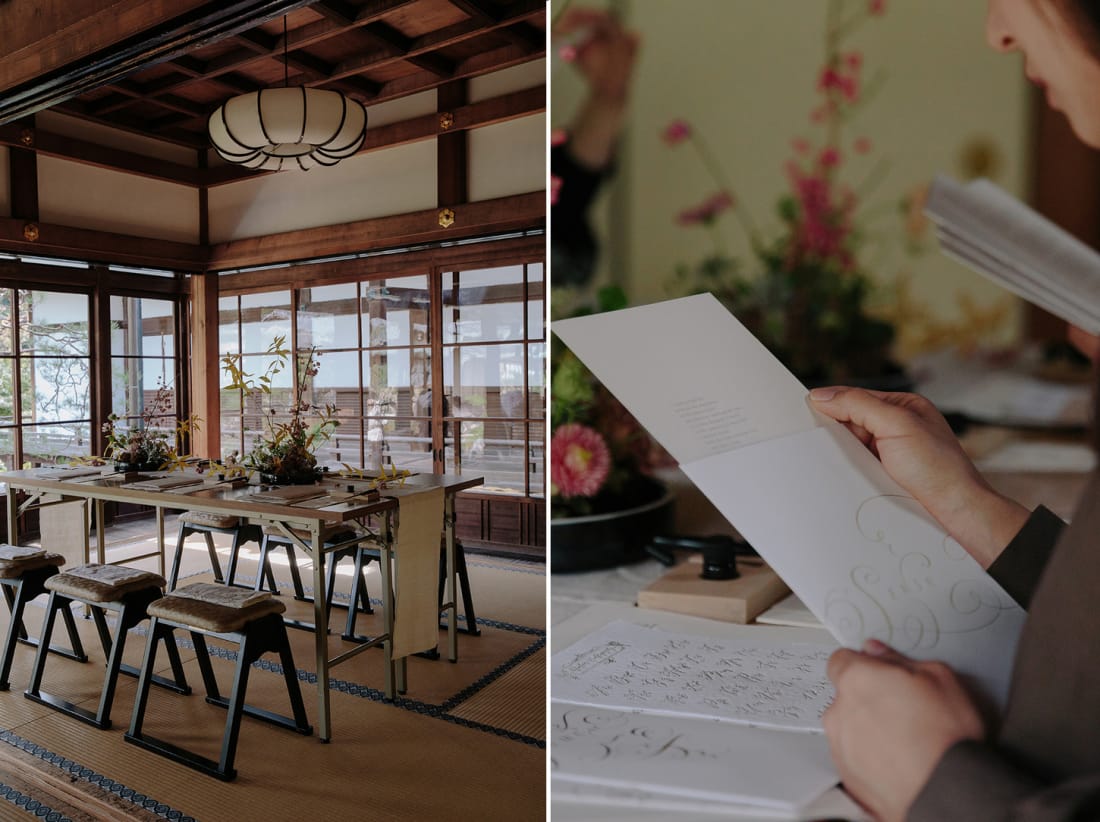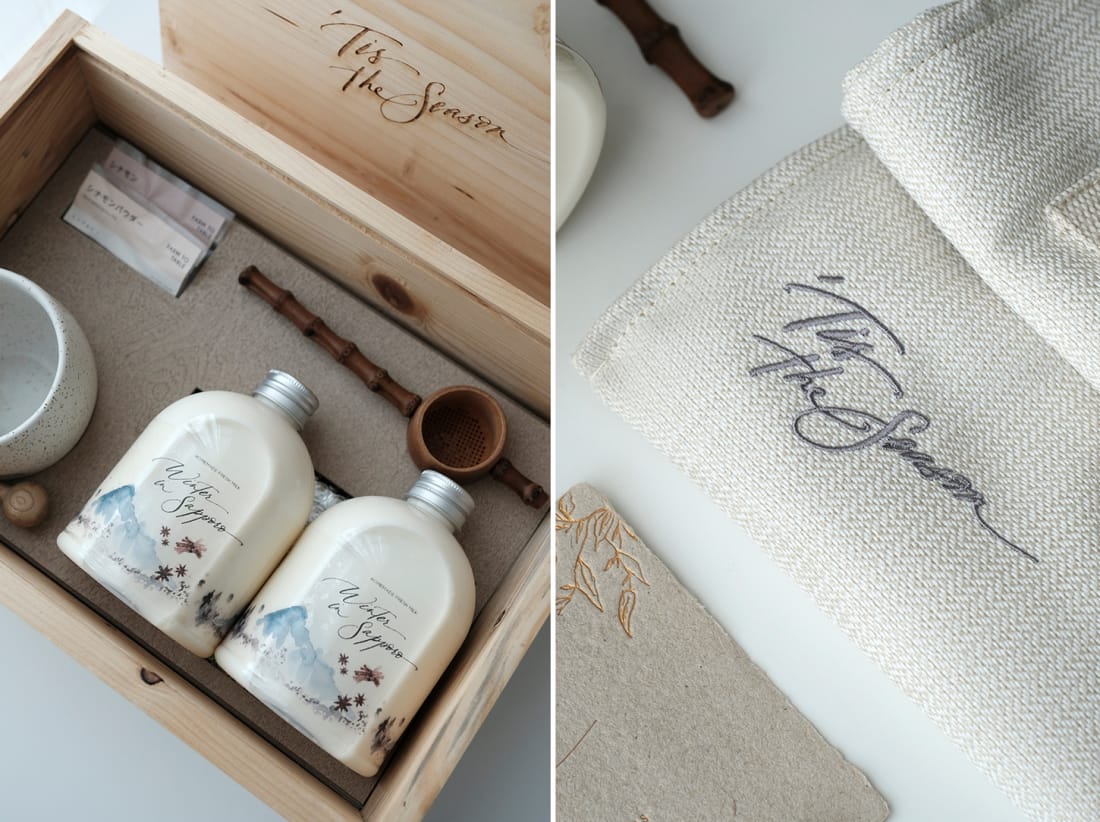It took me one glance (and an Instagram swipe) to fall in love with the beauty of Veronica Halim’s penmanship. From mastering the intricacy of copperplate script to the injection of delicate curlicues, her calligraphy can best be described as a dreamy merging of what has been and what is now. It’s exactly how she garners high-profile clients including BMW, Montblanc, Love Liner, Chanel, Dior and Clé de Peau. Then there’s her mass of online followers — myself recently included. Her success boils down to the importance of the conceptual approach and technical expertise in blending modern flair with traditional practice.
The Indonesian calligrapher has become a frequent collaborator and workshop host in Japan. Just last year, she teamed up with Ryosokuin Temple in Kyoto for a special New Year workshop, which consisted of sutra chanting, Zen meditation and her rendition of kakizome (first calligraphy of the year). Veronica also wrote her first book Calligraphy Styling in 2017 under Japanese publishing company Shufunotomo. Currently launching her project with Japanese fashion brand Global Work, our thirty-minute-turned-two-hour catch-up wasn’t enough to fully encapsulate her artistic brilliance.
1. How did you discover calligraphy and what was the appeal?
Calligraphy’s one of the simplest art forms you can do at home. That’s the initial reason I fell in love with it when I was at university. However, between working and setting up my studio, I didn’t have the time to pursue it seriously. I worked in the corporate design industry for 15 years before switching to calligraphy and wedding stationery design full-time. Back then, I dealt with lots of corporate clients and felt my creative freedom was being restricted. I needed a way to meditate and take my mind away from work. I started with ceramics, but that became time-consuming as you have to go back-and-forth to the studio. That’s when I revisited calligraphy. At one point, I thought, ‘Why not pick it up again?’ From there, I started practicing every day and fell in love with it again. I never imagined it would become a full-time career.
2. How would you describe your calligraphy style?
People often misunderstand the differences between modern and traditional calligraphy. Modern calligraphy takes inspiration from traditional writing, which also branches to different styles: Copperplate, Spencerian, Gothic, Italic and many more. I started with modern calligraphy as you have more freedom, although you don’t necessarily disregard all the rules. Eventually, I began to practice Copperplate, Spencerian and other traditional calligraphy styles.
As an artist, I never want to box myself in. I always expect some surprises along the way.
Now, I do both modern and traditional calligraphy. Those who follow my work will probably describe my style as classic, timeless and elegant. In terms of my personal style, I don’t think I can break it down into just one. I’m both a minimalist and maximalist. I love the minimalism of the Japanese interior but have grown to admire Renaissance, French Baroque and classical architecture that’s usually more ornate and louder. I always try to adapt and fit my calligraphy to different environments. Also, I like to explore and open up to new things. That’s why I enjoy doing collaborations. As an artist, I never want to box myself in. I always expect some surprises along the way.
3. Do you have any favorite tools, types of brushes and pens, or papers you prefer to work with?
I have my favorites, of course, but there are just too many. That’s why I love coming to Japan. With many great stationery shops here, I always make sure to visit them whenever I return. There’s a broad range of papers, pens and inks you can choose from. Generally, I would say good-quality paper is the most important. Not all calligraphy paper can take inks well. Sometimes, the inks can bleed, which is the last thing you want, so researching the right paper is crucial. Although in the end, you can’t take one away from the other. All things have to match: the ink, the paper and the pen.
4. Where do you find your inspiration?
Everywhere. I love going to museums and art galleries when I’m on a creative block.
5. How did you come to host regular workshops in Japan? Why were you initially drawn to this country?
There was only a small community that was into calligraphy a few years ago. No one really knew about the art except for a few designers and creatives. It wasn’t something trendy. I hosted my first workshop for friends after I introduced them to the art. It was just for fun — some light practices over coffee — but that opened up more doors for me. People started to notice the beauty behind calligraphy and asking me to host more workshops.
The opportunity to kickstart my first workshop in Japan came in 2016. I’ve always loved to strike a conversation with local friends, shop owners, florists and restaurant owners in Japan. I would mention my job as a calligrapher and, just like that, casual chats turned into collaborations. I think now, more than ever, people are looking for new ways to feel zen in this fast-paced world.
People are always afraid of trying something new. I wanted them to break free of any expectations and loosen up.
A few years ago, I did a workshop in a private temple in Kyoto. That, too, started from a small talk with the head monk. It just so happens there’s a common theme with meditation and calligraphy. Both are about focusing on the moment. We decided to do Zen meditation, a calligraphy writing session and a tea ceremony. Combining Western elements in terms of calligraphy with deep Japanese traditions was quite an experience. There, I shifted my focus from teaching the technical aspect of writing to urging my students to ‘let go’ — something I feel is missing in Japan. People are always afraid of trying something new. I wanted them to break free of any expectations and loosen up.
6. You’ve also collaborated with a lot of local artists in Japan. Can you tell us a bit more about the process and how you got involved?
It’s always exciting to collaborate with Japanese artists. Those I’ve worked with are masters in their craft and it’s easy to admire their work. As artists, we know how to give each other room for creativity. As I don’t speak Japanese, we communicate in basic English. Still, all of my collaborations and workshops turned out well. It just shows how language isn’t a barrier to creativity — it’s all about mutual respect.
For my collaboration with Ponte Glass, I wanted to create a bottle inspired by an ink spill. When you look at waterdrops, you will notice that none of them retain the same shape — that’s the idea behind it. I came up with the initial concept, but I gave Satoshi Sato, the glassmaker, creative freedom. The artist had handblown each bottle into the shape of a waterdrop. I gave him complete trust with his interpretations and loved how they all turned out. Each bottle had its own unique quality.
7. How do you feel calligraphy is regarded in Japan?
I suppose it’s different in every country. Habit and culture play a big part in how people perceive art. In particular, calligraphy in Japan is more strongly associated with traditional Japanese shodo. There was only a handful of modern calligraphy workshops here. People also think that you needed a big commitment to start calligraphy. I wanted to show them that calligraphy is a relatable art, one that anyone can practice in their daily lives. The big difference that I saw was how my Japanese students are more resilient. From embroideries to traditional crafts, they take art seriously and want to see results. I know several Japanese students who’ve been following me for three or four years. They still bring my past notes and study materials to my workshops.
8. Why did you decide to release Calligraphy Styling in Japan? What do you hope readers get from it?
The idea behind the book is to introduce calligraphy as something that is approachable in a modern setting — even though it’s technically a dying art. People tend to hold this dated image of calligraphy. I wanted to show them that we can incorporate it into our daily lives. From my visits to Japan, I found that calligraphy was an important skill to learn for small businesses, from florists to small shop owners. They could use it to make packaging, create labels and for plating. That was the idea behind my book launch.
We can always take these exciting traditional elements and combine them in a modern setting.
Calligraphy Styling was the first book I wrote in 2017. It has different chapters dedicated to different businesses: Food, florists, wedding venues and more. My second book called Calligraphy Lifestyle was released in 2020 and in that one I dived deeper into how I find inspiration. A lot of times, people struggle to find their personal style and I wanted to help them step out of this creative block.
9. How have your experiences hosting workshops and working with international clients influenced you as a creative?
They’ve definitely made me more open-minded. In Shanghai, Japan and Indonesia, I’m fascinated by traditions that are deemed “too traditional.” I wanted to bring these old elements back and mix them with contemporary aesthetics. Growing up, I was exposed to different cultures. I guess that made me open to the cultural aspect of my work. In Indonesia, a traditional wedding involves vibrant dresses and loud, bold color palettes. In Japan, there are many dying arts and traditions that deserve more recognition, such as Origata. It’s important to preserve them as we move on. From my point of view, we can always take these exciting traditional elements and combine them in a modern setting.
10. What tips would you give to someone new in calligraphy or anyone trying to make it in this creative industry?
Practice is always the key. Even though there are so many applications of calligraphy, always go back to the strong core basics. You need to keep experimenting and finding your own style, especially when you’re new. Also, try different things. That’s what I try to do as a creative director. It’s important to push my designers to be curious— to not become fixated and confined inside the design industry and instead find inspiration everywhere.
Veronica Halim is currently launching her collaboration project with popular casual fashion brand Global Work Japan, where she designs calligraphic patterns for men’s summer shirts and pants collections.
Follow her on Instagram at @truffypi or visit her website here.
All photos in this article are courtesy of Veronica Halim. This interview has been edited for brevity
Updated On July 9, 2021

